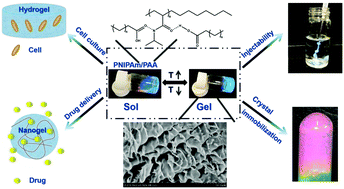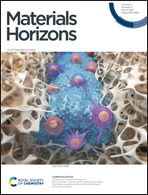In situ formed thermogelable hydrogel photonic crystals assembled by thermosensitive IPNs†
Abstract
In this paper, soft thermosensitive photonic crystals are immobilized via a reversible temperature-triggered in situ sol–gel transition above their phase transition temperature (Tp), which may be a significant advance in the field. Specifically, a library of thermosensitive poly(N-isopropylacrylamide)/poly(acrylic acid) (PNIPAm/PAA) interpenetrating nanogels (IPNs) is synthesized, which can achieve a reversible temperature-induced sol–gel transition at a low concentration (1.1 wt%). More interestingly, as the temperature is increased above Tp, the photonic crystals assembled by these IPNs do not disappear but are “immobilized” in the in situ formed hydrogel matrix. Moreover, these colorful IPN dispersions exhibit outstanding syringe-injectability, immediately turning from an aqueous solution into an insoluble hydrogel as they are injected into PBS at 37 °C. Plus, a protein-release study showed that these injectable hydrogels show extended release times and slower release rates in comparison with dilute nanogel dispersions. In brief, these in situ formed hydrogels with brilliant structural colors have potential in optical applications, e.g., color displays, crystal immobilization, and biological applications, e.g., 3D cell culture and drug delivery.



 Please wait while we load your content...
Please wait while we load your content...